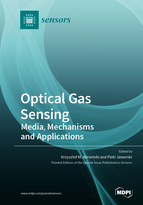Optical Gas Sensing: Media, Mechanisms and Applications
A special issue of Sensors (ISSN 1424-8220). This special issue belongs to the section "Optical Sensors".
Deadline for manuscript submissions: closed (31 December 2021) | Viewed by 33605
Special Issue Editors
Interests: laser spectroscopy; laser gas sensing; laser frequency stabilization; gas lasers; slab and multichannel CO2 RF excited lasers; microchip solid-state single-frequency lasers; laser vibrometry; laser heterodyning; optical fiber combs; mode-locking; femtosecond fiber lasers; phase-locking of laser beams
Interests: laser-based spectroscopy; laser-based gas sensing; microstructured optical fibers; hollow-core photonic crystal fibers; fiber lasers
Special Issues, Collections and Topics in MDPI journals
Special Issue Information
Dear Colleagues,
Optical gas sensing is one of the fastest developing research areas of laser spectroscopy. Continuous development of new coherent light sources operating in the Mid-IR and Far-IR regions (QCL - Quantum Cascade Lasers, ICL – Intraband Cascade Lasers , OPO – Optical Parametric Oscillator, DFG - Difference Frequency Generation, optical combs etc.) stimulate new sophisticated methods and technological solutions in this area. Development of clever techniques of gas detection based on new mechanisms of sensing (photoacoustic, photothermal, dispersion etc.) supported by advanced applied electronics and huge progress in signal processing allow to introduce more sensitive, more broadband and miniaturized optical sensors. Additionally, substantial advancement of fast and sensitive photodetectors in MIR and FIR supports very much gas sensing progress.
Recent material and technological progress in the development of hollow-core optical fibers allowing low-loss transmission in both NIR and MIR opens a new route for obtaining low volume long optical paths so strongly required in laser-based gas sensors. The first successful demonstrations of using hollow-core fibers as gas absorption cells have been already demonstrated. The next important subject in the area opening huge possibilities is based on frequency comb spectroscopy, with its recent mutation – dual-comb spectroscopy. Furthermore, recently introduced, the so called laser-intra-cavity heterodyne gas detection technique seems to make important progress in improving sensitivity and miniaturization of the sensors.
The aim of this Special Issue is to give some insight into trends in optical gas sensing, including new visions, new techniques, novel materials and devices.
Topics include, but are not limited to the following:
- absorption spectroscopy
- photoacoustic and photothermal spectroscopy
- dispersion spectroscopy
- frequency comb spectroscopy
- heterodyne-based techniques
- optical fibers
- mid-infrared laser sources
- remote sensing
- application of laser based gas sensors
Prof. Dr. Krzysztof M. Abramski
Dr. Piotr Jaworski
Guest Editors
Manuscript Submission Information
Manuscripts should be submitted online at www.mdpi.com by registering and logging in to this website. Once you are registered, click here to go to the submission form. Manuscripts can be submitted until the deadline. All submissions that pass pre-check are peer-reviewed. Accepted papers will be published continuously in the journal (as soon as accepted) and will be listed together on the special issue website. Research articles, review articles as well as short communications are invited. For planned papers, a title and short abstract (about 100 words) can be sent to the Editorial Office for announcement on this website.
Submitted manuscripts should not have been published previously, nor be under consideration for publication elsewhere (except conference proceedings papers). All manuscripts are thoroughly refereed through a single-blind peer-review process. A guide for authors and other relevant information for submission of manuscripts is available on the Instructions for Authors page. Sensors is an international peer-reviewed open access semimonthly journal published by MDPI.
Please visit the Instructions for Authors page before submitting a manuscript. The Article Processing Charge (APC) for publication in this open access journal is 2600 CHF (Swiss Francs). Submitted papers should be well formatted and use good English. Authors may use MDPI's English editing service prior to publication or during author revisions.
Keywords
- absorption spectroscopy
- photoacoustic spectroscopy
- photothermal spectroscopy
- heterodyne detection
- dispersion spectroscopy
- frequency comb spectroscopy
- microsctructured optical fibers
- hollow-core fibers
- mid-infrared lasers
- laser-based gas sensing
- remote sensing
- laser sources
- gas sensing applications, signal processing







